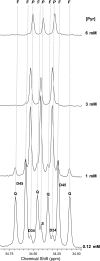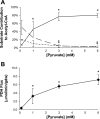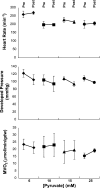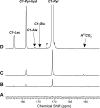Competition of pyruvate with physiological substrates for oxidation by the heart: implications for studies with hyperpolarized [1-13C]pyruvate
- PMID: 20207817
- PMCID: PMC2867437
- DOI: 10.1152/ajpheart.00656.2009
Competition of pyruvate with physiological substrates for oxidation by the heart: implications for studies with hyperpolarized [1-13C]pyruvate
Abstract
Carbon 13 nuclear magnetic resonance (NMR) isotopomer analysis was used to measure the rates of oxidation of long-chain fatty acids, ketones, and pyruvate to determine the minimum pyruvate concentration ([pyruvate]) needed to suppress oxidation of these alternative substrates. Substrate mixtures were chosen to represent either the fed or fasted state. At physiological [pyruvate], fatty acids and ketones supplied the overwhelming majority of acetyl-CoA. Under conditions mimicking the fed state, 3 mM pyruvate provided approximately 80% of acetyl-CoA, but under fasting conditions 6 mM pyruvate contributed only 33% of acetyl-CoA. Higher [pyruvate], 10-25 mM, was associated with transient reduced cardiac output, but overall hemodynamic performance was unchanged after equilibration. These observations suggested that 3-6 mM pyruvate in the coronary arteries would be an appropriate target for studies with hyperpolarized [1-(13)C]pyruvate. However, the metabolic products of 3 mM hyperpolarized [1-(13)C]pyruvate could not be detected in the isolated heart during perfusion with a physiological mixture of substrates including 3% albumin. In the presence of albumin even at high concentrations of pyruvate, 20 mM, hyperpolarized H(13)CO(3)(-) could be detected only in the absence of competing substrates. Highly purified albumin (but not albumin from plasma) substantially reduced the longitudinal relaxation time of [1-(13)C]pyruvate. In conclusion, studies of cardiac metabolism using hyperpolarized [1-(13)C]pyruvate are sensitive to the effects of competing substrates on pyruvate oxidation.
Figures







References
-
- Bae Kyongtae T, Tran Huy Q, Heiken Jay P. Uniform vascular contrast enhancement and reduced contrast medium volume achieved by using exponentially decelerated contrast material injection method. Radiology 231: 732–736, 2004 - PubMed
-
- Bassenge E, Wendt VE, Schollmeyer P, Bluemchen G, Gudbjarnason S, Bing RJ. Effect of ketone bodies on cardiac metabolism. Am J Physiol 208: 162–168, 1965 - PubMed
-
- Bing RJ, Siegel A, Ungar I, Gilbert M. Metabolism of the human heart. II. Studies on fat, ketone and amino acid metabolism. Am J Med 16: 504–515, 1954 - PubMed
-
- Bunger R, Mallet RT, Hartman DA. Pyruvate-enhanced phosphorylation potential and inotropism in normoxic and postischemic isolated working heart. Near-complete prevention of reperfusion contractile failure. Eur J Biochem 180: 221–233, 1989 - PubMed
Publication types
MeSH terms
Substances
Grants and funding
LinkOut - more resources
Full Text Sources
Other Literature Sources

